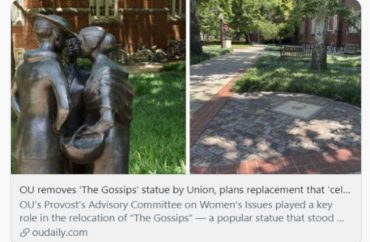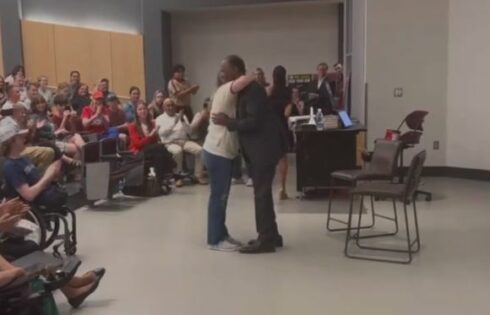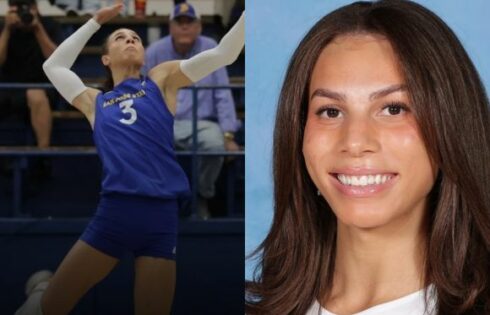
In July, the University of Oklahoma removed from campus a bronze statue that featured three women huddled together talking amid complaints the depiction was demeaning to women.
A document recently obtained by The College Fix details the complaints a women’s advisory committee lodged against “The Gossips,” which had stood at the school since 2007.
In February, Oklahoma Law Professor Melissa Mortazavi, who chairs the Provost’s Advisory Committee on Women’s Issues, emailed a copy of a memo recommending removal of the statue to Vice Provost Lori Snyder.
In the memo, the committee wrote that the statue “reinforces negative stereotypes of women” and objected to the prominent placement of the statue, “where a large segment of the campus community passes it daily.”
“Entitling the sculpture ‘The Gossips’ trivializes women’s communication,” the committee wrote. “As a noun, gossip is defined as ‘idle talk or rumor, especially about the personal or private affairs of others’ (Dictionary.com) or ‘a person who habitually reveals personal or sensational facts about others’ (Merriam-Webster.com). The word thus suggests women’s communication is not only trivial but also unkind or hurtful.”
The committee members also objected to the size of the statue.
“The small size of the sculpture reinforces the idea that women are small people who talk about unimportant things. To appreciate the gender stereotyping, one need only consider whether a similar sculpture featuring male figures would be similarly titled: it is hard to imagine that men’s talk would be called ‘gossip.’”
According to emails obtained by The College Fix, Provost Jill Irvine forwarded a copy of the memo to President Joseph Harroz on March 23, suggesting they discuss it in their meeting to be held that day.
“I am strongly in favor of removing this statute from its current location and, if it is situated in a different public location on campus, of renaming it,” Irvine wrote to Harroz.
On March 28, Vice President for Executive Affairs Sean Burrage emailed Irvine back to tell her Harroz had decided to remove the statue.
In June, as the statue’s removal neared, the school’s marketing arm kicked into gear.
Mackenzie Dilbeck, the school’s Vice President of Marketing and Communications, emailed Harroz and Burrage to tell them they had begun getting questions about the statue from school employees, and media questions would most likely follow. Dilbeck suggested a prepared statement:
“After many inquiries from OU community members and alumni, and at the request of and in consultation with the Provost’s Advisory Committee on Women’s Issues, it was determined to rotate the location of the statue from its location next to the student union with a piece that celebrates women’s leadership at the University of Oklahoma,” the statement read.
When reached for comment on Friday, a spokesperson for OU sent the following statement:
“After many inquiries from OU community members and alumni, and at the request of and in consultation with the Provost’s Advisory Committee on Women’s Issues, it was determined to rotate the Gossips statue from its location next to the student union with a piece that celebrates women’s leadership at the University of Oklahoma, which has not yet been selected.”
The statue itself was created in 1980 by Harry Marinsky, a famous sculptor whose parents fled Russian pogroms in the late 19th century. After being born in London in 1909, Marinsky’s family moved to Rhode Island when he was three years old. He began sculpting after World War II.
The Gossips was a gift to the school by former OU President David Boren and his wife, Molly Boren.
“The close proximity of their finely chiseled facial features suggests the secretive tone of their conversation,” describes the Museum of Outdoor Art. “Marinsky based this sculpture on three women he witnessed gossiping at a Henry Moore exhibition…The style employed by Marinsky is simple, yet it explores the complexity of the human form and psyche.”
But the provost’s committee on women’s issues disagrees.
“Every day, women students, staff and faculty walk past the sculpture on their way to lunch or class or work or the library,” the the committee wrote in its letter objecting to the statue.
“They encounter a depiction of their gender which suggests that they are not full and equal members of the campus community, that their talk is seen as small and mean-spirited. Every day, men students, staff, and faculty walk past the sculpture and encounter a depiction of women that suggests women’s talk is not to be taken seriously. Every day, visitors to campus, including potential students, parents, and public officials, encounter this stereotypical depiction of women and draw what conclusions they will about OU’s commitment to diversity and inclusiveness.”
The Gossips statue is now housed at the Fred Jones Jr. Museum of Art.
ALERT: Check out our new Campus Cancel Culture Database!
IMAGE: Twitter screenshot
Like The College Fix on Facebook / Follow us on Twitter





Please join the conversation about our stories on Facebook, Twitter, Instagram, Reddit, MeWe, Rumble, Gab, Minds and Gettr.